The Naxi Ethnic Group
Using Torches to Save the World
According to myth, the God Zilao Ahpu was jealous of the happy life of mortals and sent an elderly general to burn the human's world. When the general flew down to the mortal world, he saw a man walking down the road with two children, the older one on his back whilst the younger one walked alongside. The general out of curiosity asked the man why he carried the elder child and not the younger one. "The child on my back is the only child of my elder brother and elder sister-in-law," said the man, "They have passed away so I have to do the best I can to take good care of my nephew." The general was moved on hearing what the man told him and thought people in the mortal world were very kind-hearted so he decided not to destroy the world. He told the man what he was supposed to do and also told the man what to do to save the beautiful world: light up torches at the gate of every house at the night of lunar 24 June. When the god took a look again at the mortal world on that day (lunar 24 June), he thought the world was on fire. For this reason the Naxi people celebrate the Torch Festival on each lunar 24 June.
The Lahu Ethnic Group
Using Fire to Vanquish the Demon
A long time ago, there was a demon living on the mountain, feeding on human's eyes. A smart man devised a plan to vanquish the demon. He told people to apply beeswax to goat horns and set them alight at night. The goat herd with burning horns were led to the mountain to frighten the demon who thought that the people were coming to kill him with spears of fire and hid in a cave. After that, the smart man asked people to block the entrance of the cave with stones. Finally, the demon was drowned in water that filled the cave. In the end, the Lahu people never needed to worry about the demon and they celebrate the Torch Festival on each 24 lunar June to commemorate the victory.
The Bai Ethnic Group
Conflagrating of the Pinewood Pavilion
During the Tang Dynasty (618-907), the Erhai Lake area was controlled by six tribes. The Mengshe tribe was in the southernmost part so was also called Nanzhao tribe. As the Nanzhao tribe was getting stronger and stronger, its chieftan Piluoge was so ambitious that he conspired to invite the other five chieftans to meet at the Pinewood Pavilion. Everyone knew the invitation was in fact a conspiracy but for the sake of their own tribes, they could not say "no". Baijie was the wife of the Dengdan tribe chieftan, she was very kind, beautiful and clever. She tried to persuade her husband not to go to the Pavilion. However, the husband insisted on going at least for the benefit of his people. When the husband departed, Baijie gave him her iron bracelet, saying that it was a talisman that would bless and protect him. When bad news came that Piluoge killed the other five chieftans by burning down the pavilion, Baijie was broken-hearted and wanted to get her husband's body back. She finally found the bracelet and recognised him in the ashes. Piluoge had heard about Baijie and wanted to make her his wife. Baijie loved his husband very much, how was it possible for her to remarry Piluoge? After finishing the funeral ceremony for her husband, she committed suicide. The Bai people in Dali celebrate the Torch Festival on each lunar 25 June in her honor.
The Sani Branch of the Yi Ethnic Group
Using Torches to Expel the Locusts on Crops
The kind-hearted god Ahfan secretly opened the gates to heaven and sprayed crop seeds to the human's world as a result of which people enjoyed a life which was better than that in the heaven. The ruler of the heavens was very angry and sent the muscular god to fight Ahfan. Ahfan wrestled with the muscular god and obtained victory in the end. When the muscular god was felled by Ahfan, a deep pit was left which then turned into the Changhu Lake. When the ruler came to know of this, it got outraged and send hundreds of millions of locusts to eat up the crops. Ahfan told people to make torches to expel the locusts on the night of lunar 24 June. In order to commemorate Ahfan, the Sani people spend the Torch Festival during which wrestling, buffalo fighting and many other activities are held.
The Axi Branch of the Yi Ethnic Group
Using Fire to Defeat the Slaver
According to a folklore, the slaver Nazhaozhao jailed two poor brothers. Azhen, a young man who was also born in a poor family, devised a way to save the two brothers. He asked people to tie torches on the sheep horns and led the herd dash to the mansion of the slaver. As a result the jailed brothers were saved and the slaver was burned to death. In order to commemorate the victory, the Axi people spend the Torch Festival on each lunar 24 June.
The Luowu Branch of the Yi Ethnic Group
The Tale of the Magpie Girl
Once upon a time a pretty Yi girl and a Yi boy (named Ahlong) lived in a Yi village. They loved each other very much. But, many men from the nearby 12 tribes went to propose marriage to the pretty girl. Among the men, there was a bossy landlord who said if the girl did not marry him he would kill all the villagers. The girl was helpless because she believed she should not be the cause of harm to her village. So she promised the landlord that she would marry him on lunar 24 June. When the day arrived the girl dressed herself in white with a black coat and flowery apron, and lit a big fire beside her. At the moment all the date participants of the 12 tribes arrived, the girl had a loving look at Ahlong and then jumped into the fire. Ahlong and several boys wanted to catch hold of her, but could only tear of a piece of her clothes. She died for love. People then spend the Torch Festival on each lunar 24 June, and the piece of the girl's clothes was said to become the belts of the aprons of Yi ethnic ladies. The smoke of the fire became the morning fog in the village. And it is said that when magpies tweet in the early morning, the girl will appear somewhere in the mountain, so she is known as amongst the Yis as the Magpie Girl.
Deemed "the oriental carnival", the Torch Festival is celebrated by several ethnic minorities including the Yi, Bai, Naxi and Lahu etc. Enjoying a long history as an important festival of these minorities, the festival exhibits quite profound cultural connotations.
Although the origin of the festival is slightly different among these minorities, it takes place on lunar 24/25 June (27-28 July) 2016. Usually a wide variety of folk activities are organised for the festival, such as bull (buffalo) fighting, goat fighting, rooster fighting, horse racing, wrestling, beauty pageant, and singing and dancing etc.
In Yunnan Province, Kunming, Chuxiong, Dali, Yuxi, Wenshan, Puer, Honghe, Lijiang and Zhaotong are the major areas for the Torch Festival as they are inhabited by the Yi or Bai people. Here are the main places recommended to experience the festival.
Shilin County (105 km)
Date: 27 July
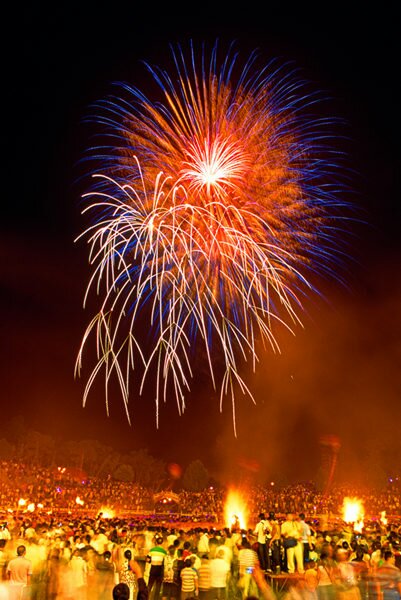 The year of 2016 is the 60th anniversary of Shilin Yi Autonomous County (normally known for the Stone Forest) which is the most popular destination for the Yi ethnic Torch Festival around Kunming. The opening ceremony of the Festival will be held on 27 July, and visitors can join in the torch carnival at Shuanglong Square in the county seat, Ashima Tourism Town and No.1 Yi Ethnic Village etc.
The year of 2016 is the 60th anniversary of Shilin Yi Autonomous County (normally known for the Stone Forest) which is the most popular destination for the Yi ethnic Torch Festival around Kunming. The opening ceremony of the Festival will be held on 27 July, and visitors can join in the torch carnival at Shuanglong Square in the county seat, Ashima Tourism Town and No.1 Yi Ethnic Village etc.
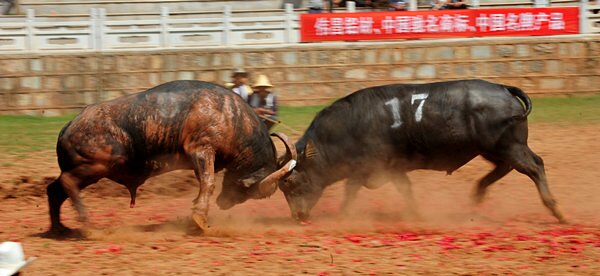 In the county, the Festival is highlighted by a large variety of cultural performances including wrestling, buffalo fighting, three-stringed guitar show, and exhibition of intangible cultural heritages etc. During 27-28 July, women wrestling and traditional wrestling events will be held at Xijiekou Town and Changhu Stadium. What is most exciting is the buffalo fighting at Changhu Stadium, Yatai Bullring and No. 1 Yi Ethnic Village.
In the county, the Festival is highlighted by a large variety of cultural performances including wrestling, buffalo fighting, three-stringed guitar show, and exhibition of intangible cultural heritages etc. During 27-28 July, women wrestling and traditional wrestling events will be held at Xijiekou Town and Changhu Stadium. What is most exciting is the buffalo fighting at Changhu Stadium, Yatai Bullring and No. 1 Yi Ethnic Village.
Route: Kunming-Shilin County (Stone Forest)
Transport
Bus ride from Kunming East Bus Station to Shilin county seat or the Stone Forest
Yunnan Nationalities Village (12 km)
Date: 27-28 July
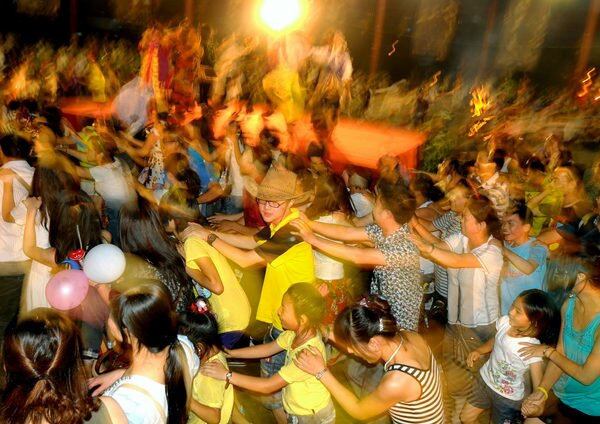 A major park to experience the Torch Festival, Yunnan Nationalities Village is one of must-visit places in Kunming. During the festival in the park, grand cultural shows will be staged, including fire sacrificial ceremony, parade, buffalo fighting and torch carnival etc. Visitors can focus on the villages of the Bai and Yi in the park.
A major park to experience the Torch Festival, Yunnan Nationalities Village is one of must-visit places in Kunming. During the festival in the park, grand cultural shows will be staged, including fire sacrificial ceremony, parade, buffalo fighting and torch carnival etc. Visitors can focus on the villages of the Bai and Yi in the park.
Route: Kunming city proper
Transport
Bus No. 24, 44,73, 94,135, 165, 184, A1, A4, A9
Luquan County (80 km)
Date: 27 July
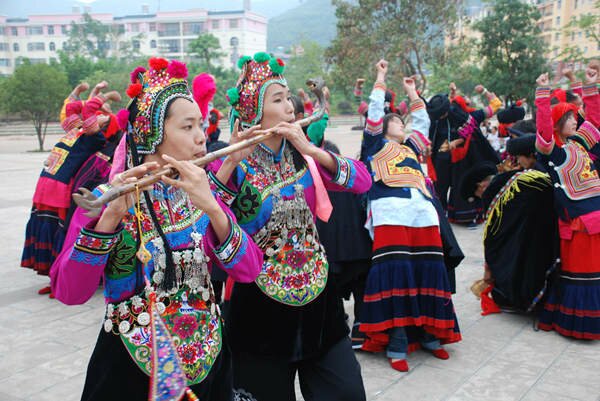 Among the total population of Luquan Yi and Miao Autonomous County, minorities account for about 30% most of whom are the Yi and Miao people. Like many other Yi-inhabited areas, the locals spend the Torch Festival on each lunar 24 June and the festival lasts for at least three days. Sacrificial ceremonies, dancing and singing are what visitors can experience in Luquan. Besides, in the county seat, bon fire parties and trade fair will be organised highlighted by the local ethnic embroideries.
Among the total population of Luquan Yi and Miao Autonomous County, minorities account for about 30% most of whom are the Yi and Miao people. Like many other Yi-inhabited areas, the locals spend the Torch Festival on each lunar 24 June and the festival lasts for at least three days. Sacrificial ceremonies, dancing and singing are what visitors can experience in Luquan. Besides, in the county seat, bon fire parties and trade fair will be organised highlighted by the local ethnic embroideries.
Route: Kunming-Luquan County
Transport
Bus ride from Kunming Northwest Bus Station
Xundian County (110 km)
Date: 24 July
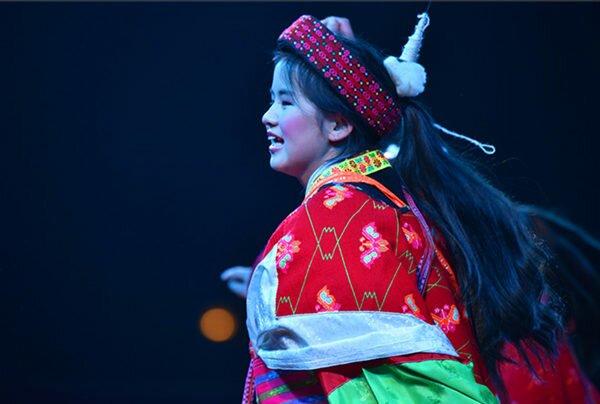 In the local Yi language, the Torch Festival is called "Chu Nuo Shu". It is the grandest and most jubilant festival of the Yi people in Luquan Hui and Yi Autonomous County. In the county seat each year, a lighting ceremony is presided over by Yi ethnic Bimo (priests) to announce the beginning of the torch carnival.
In the local Yi language, the Torch Festival is called "Chu Nuo Shu". It is the grandest and most jubilant festival of the Yi people in Luquan Hui and Yi Autonomous County. In the county seat each year, a lighting ceremony is presided over by Yi ethnic Bimo (priests) to announce the beginning of the torch carnival.
Route: Kunming-Songming County-Xundian County
Transport
Bus ride from Kunming North Bus Station
Eshan County (105 km)
Date: 22-24 July
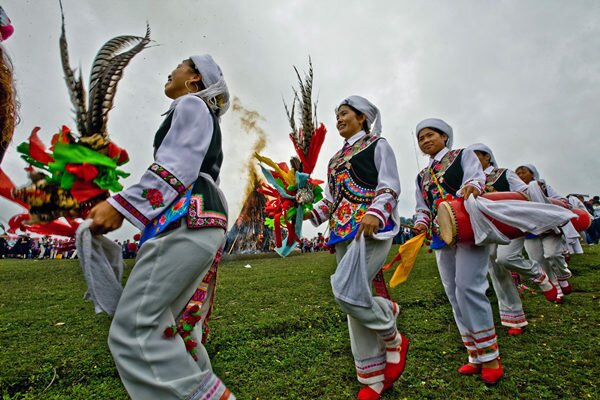 Eshan of Yuxi City is the first Yi autonomous county in China with the Yi people accounting for at least 50% of the total population. The year of 2016 is the 65th anniversary of Eshan Yi Autonomous County and a two-week-long event(15-30 July)will be organised here, including the Torch Festival (22-24 July) and Eshan Yi Ethnic Gourmet Contest (19 July) in the county seat.
Eshan of Yuxi City is the first Yi autonomous county in China with the Yi people accounting for at least 50% of the total population. The year of 2016 is the 65th anniversary of Eshan Yi Autonomous County and a two-week-long event(15-30 July)will be organised here, including the Torch Festival (22-24 July) and Eshan Yi Ethnic Gourmet Contest (19 July) in the county seat.
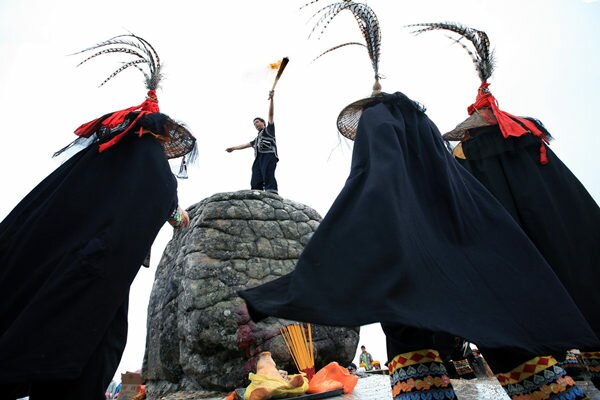 The main activities of Eshan Torch Festival include the ceremony of making fire, ancestor worship ceremony and traditional cultural performances etc. Among the sites to visit during the Festival, Apudumu Square is the must where a grand traditional ancestor worship ceremony will take place.
The main activities of Eshan Torch Festival include the ceremony of making fire, ancestor worship ceremony and traditional cultural performances etc. Among the sites to visit during the Festival, Apudumu Square is the must where a grand traditional ancestor worship ceremony will take place.
Route: Kunming-Yuxi City-Eshan County
Transport
Bus ride from Kunming South Bus Station
Chuxiong Prefecture (150 km)
Date: 24 July
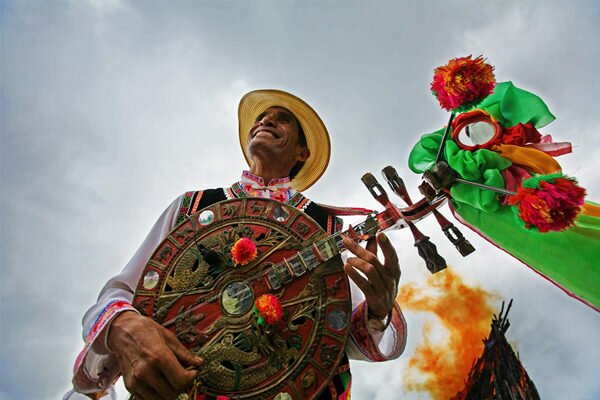 Chuxiong Yi Autonomous Prefecture in Central Yunnan is the largest Yi-inhabited area in Yunnan Province, with its capital town being Chuxiong city which is about 150 km from Kunming. The Yi people account for nearly 30% of the total of Chuxiong Prefecture, and Chuxiong must be the second place known for the Yi people's torch festival following Liangshan Prefecture of Sichuan Province. A dozen places in Chuxiong Prefecture can be obviously on visitors' itineraries including the Yi People's Ancient Town (156 km), Nanhua County (200 km), Shuangbai County (220 km), Gaofeng Town (260 km) of Lufeng County, Wutai Mt (150 km, 23-24 July) of Lufeng County, Bailu Town (164 km) of Wuding County, Mouding County (200 km) and Yuanmou County (165 km) etc.
Chuxiong Yi Autonomous Prefecture in Central Yunnan is the largest Yi-inhabited area in Yunnan Province, with its capital town being Chuxiong city which is about 150 km from Kunming. The Yi people account for nearly 30% of the total of Chuxiong Prefecture, and Chuxiong must be the second place known for the Yi people's torch festival following Liangshan Prefecture of Sichuan Province. A dozen places in Chuxiong Prefecture can be obviously on visitors' itineraries including the Yi People's Ancient Town (156 km), Nanhua County (200 km), Shuangbai County (220 km), Gaofeng Town (260 km) of Lufeng County, Wutai Mt (150 km, 23-24 July) of Lufeng County, Bailu Town (164 km) of Wuding County, Mouding County (200 km) and Yuanmou County (165 km) etc.
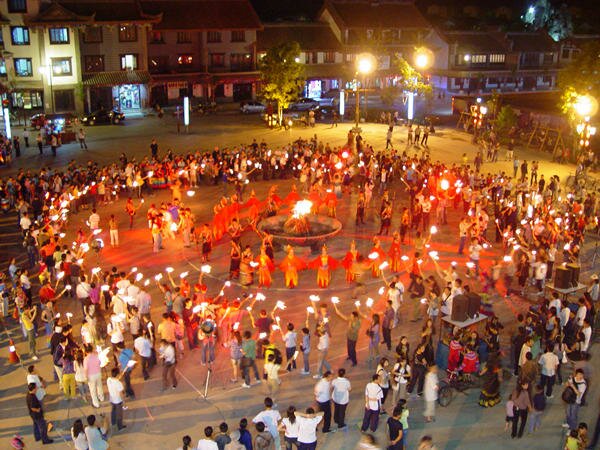 The best place to experience the Yi ethnic culture is the Yi People's Ancient Town (156 km). Constructed in the 2000s though, the Town is home to a great number of cultural sites which include the Solar Calendar Park and Chuxiong Prefectural Museum etc. What is worth mentioning is that the Left-foot Dance of Chuxiong's Yi people is unique in China; and anyone is welcome to join the locals to dance up.
The best place to experience the Yi ethnic culture is the Yi People's Ancient Town (156 km). Constructed in the 2000s though, the Town is home to a great number of cultural sites which include the Solar Calendar Park and Chuxiong Prefectural Museum etc. What is worth mentioning is that the Left-foot Dance of Chuxiong's Yi people is unique in China; and anyone is welcome to join the locals to dance up.
Route: Kunming-Chuxiong Prefecture; Kunming-Wuding County
Transport
Bus/train ride from Kunming West Bus Station/Kunming Railway Station to Chuxiong
Dali City (335 km)
Date: 28 July
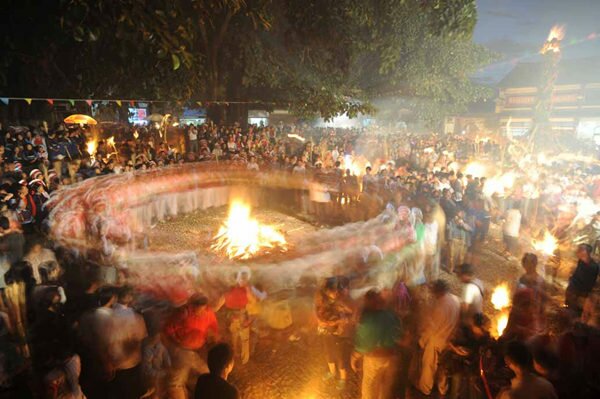 Different from the Yi people, the Bai ethnic Torch Festival takes place one day later, i.e. on 25 lunar June. In Dali, every Bai village makes a huge Torch on which are hung assorted sacrifices such as candies and fruits. The Buddhists will chant in front of the Torch to exorcise and pray for good luck and bumper harvest for villagers.
Different from the Yi people, the Bai ethnic Torch Festival takes place one day later, i.e. on 25 lunar June. In Dali, every Bai village makes a huge Torch on which are hung assorted sacrifices such as candies and fruits. The Buddhists will chant in front of the Torch to exorcise and pray for good luck and bumper harvest for villagers.
Route: Kunming-Chuxiong Prefecture-Dali
Transport
(1)-Flight from Kunming to Dali
(2)-Bus ride from Kunming West Bus Station
(3)-Train ride from Kunming Railway Station
Weishan County (380 km)
Date: 27 July
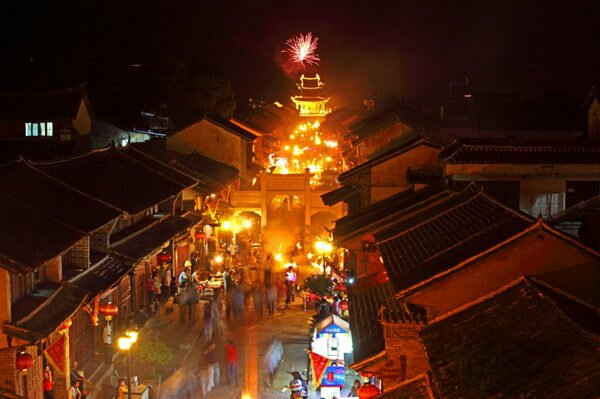 Weishan is the ancient capital of the Nanzhao Kingdom (738-937) during the Tang Dynasty (618-907). In Weishan old town, visitors can buy small torches and join the locals to dance up to celebrate the authentic Yi ethnic Torch Festival at night.
Weishan is the ancient capital of the Nanzhao Kingdom (738-937) during the Tang Dynasty (618-907). In Weishan old town, visitors can buy small torches and join the locals to dance up to celebrate the authentic Yi ethnic Torch Festival at night.
Route: Kunming-Chuxiong Prefecture-Xiangyun County-Weishan County
Transport
Bus ride from Kunming West Bus Station
Mi'le City (130 km)
Date: 27 July
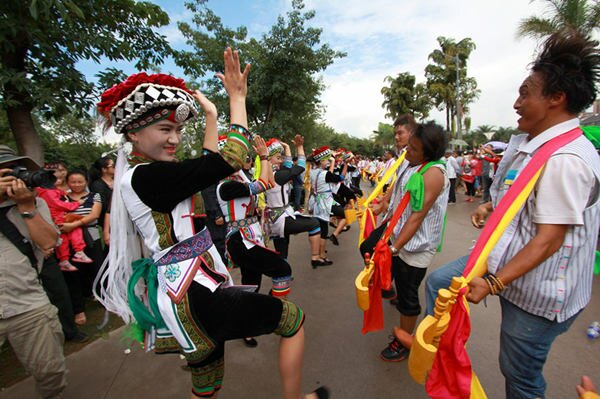 In Mi'le City of Honghe Hani and Yi Autonomous Prefecture, the Torch Festival is mainly celebrated by the Axi branch, and the most popular place is the Xisan Town 120 km from Kunming. A variety of cultural activities will be organised among which the highlights are the torch carnival and the Axi people's traditional dance locally called "Ah Xi Tiao Yue".
In Mi'le City of Honghe Hani and Yi Autonomous Prefecture, the Torch Festival is mainly celebrated by the Axi branch, and the most popular place is the Xisan Town 120 km from Kunming. A variety of cultural activities will be organised among which the highlights are the torch carnival and the Axi people's traditional dance locally called "Ah Xi Tiao Yue".
Route: Kunming-Shilin County-Mi'le City
Transport
Bus ride from Kunming East Bus Station
Puzhehei Resort(330 km)
Date: 27 July
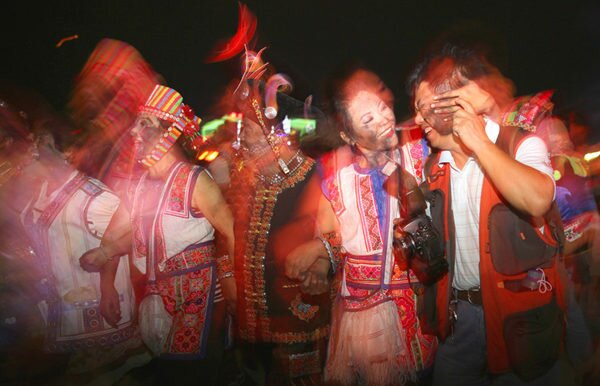 In Puzhehei Resort of Qiubei County, the Torch Festival is mainly celebrated by the Sani branch of the Yi ethnic group. Another interesting event in Puzhehei is the Yi ethnic Face Painting Festival annually held on 18 July. The Face Painting Festival is unique to the Yi people in Qiubei County; it is said to originate from an ancient tradition that people painted their faces black in order to expel the evil. Enjoying a history of more than 1,000 years, the Festival today has become a tradition for the young people to seek their Mr or Mrs White. July is the best time to visit Puzhehei, and visitors can not only join in the water fighting in the lakes, but also join the locals to celebrate the Festival.
In Puzhehei Resort of Qiubei County, the Torch Festival is mainly celebrated by the Sani branch of the Yi ethnic group. Another interesting event in Puzhehei is the Yi ethnic Face Painting Festival annually held on 18 July. The Face Painting Festival is unique to the Yi people in Qiubei County; it is said to originate from an ancient tradition that people painted their faces black in order to expel the evil. Enjoying a history of more than 1,000 years, the Festival today has become a tradition for the young people to seek their Mr or Mrs White. July is the best time to visit Puzhehei, and visitors can not only join in the water fighting in the lakes, but also join the locals to celebrate the Festival.
Route: Kunming-Mi'le-Puzhehei
Transport
Bus ride from Kunming East Bus Station
Nanjian County (342 km)
Date: 28 July
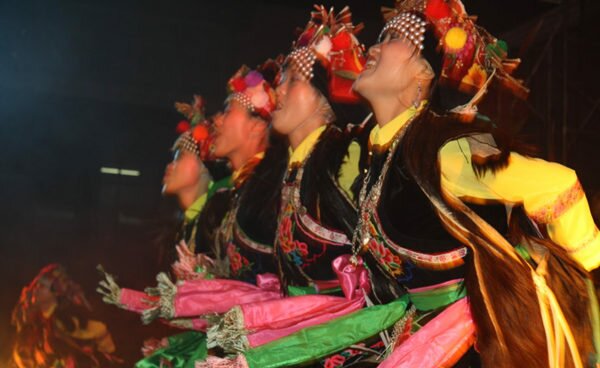 Nanjian Yi Autonomous County in the west of Yunnan is the hometown of Tiaocai Art (serving dishes in a dancing way). Lunar June is the month the locals celebrate the Torch Festival. Main activities include torch carnival, Dage show (dance) and Tiaocai Performance etc.
Nanjian Yi Autonomous County in the west of Yunnan is the hometown of Tiaocai Art (serving dishes in a dancing way). Lunar June is the month the locals celebrate the Torch Festival. Main activities include torch carnival, Dage show (dance) and Tiaocai Performance etc.
Route: Kunming-Chuxiong Prefecture-Xiangyun County-Midu County-Nanjian County
Transport
Bus ride from Kunming West Bus Station
Jingdong County (450 km)
Date: 27 July
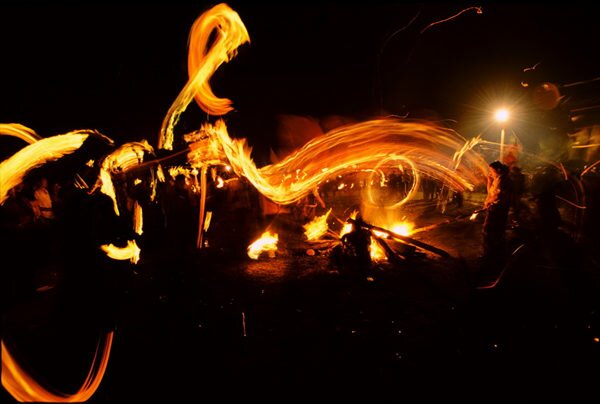 In the Southwest of Yunnan Province, Jingdong Yi Autonomous County is under the jurisdiction of Puer City. The Yi ethnic group account for nearly 40% of the total of Jingdong, so the Torch Festival is very important for the locals. Among the assorted cultural activities during the festival, the performance of local Yi ethnic three-stringed guitars is the highlight.
In the Southwest of Yunnan Province, Jingdong Yi Autonomous County is under the jurisdiction of Puer City. The Yi ethnic group account for nearly 40% of the total of Jingdong, so the Torch Festival is very important for the locals. Among the assorted cultural activities during the festival, the performance of local Yi ethnic three-stringed guitars is the highlight.
Route: Kunming-Chuxiong Prefecture-Xiangyun County-Midu County-Nanjian County-Jingdong County
Transport
Bus ride from Kunming West Bus Station